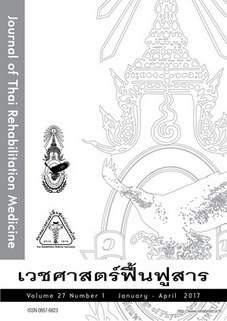การศึกษาความตรงเชิงเกณฑ์ของแบบสอบถาม PHQ-9 และ PHQ-2 ฉบับภาษาไทย ในการคัดกรองโรคซึมเศร้าในผู้สูงอายุชาวไทย
การศึกษาความตรงเชิงเกณฑ์ของแบบสอบถาม PHQ-9 และ PHQ-2 ฉบับภาษาไทย ในการคัดกรองโรคซึมเศร้าในผู้สูงอายุชาวไทย
Keywords:
validity, major depression, Patient Health Questionnaire, PHQ-9, PHQ-2Abstract
Objectives: To assess the criterion validity of the Thai version of the 9- and the 2-questions of the Patient Health Questionnaire (PHQ-9 and PHQ-2) as screening instruments for major depression in Thai elderly.
Study design: Cross sectional analytic study
Setting: The outpatient clinic and the inpatient ward of the Department of Rehabilitation Medicine, the inpatient wards of the Department of Internal Medicine and the geriatric clinic, Siriraj Hospital
Subjects: Thai patients, aged more than or equal to 60 years, attending at Siriraj Hospital during October 2014-September 2015
Methods: Each patient was assessed by the Thai version of the PHQ-9 and the Thai version of major depressive episode module of Mini International Neuropsychiatric Interview (M.I.N.I.). The PHQ-2 consisted of the first 2 questions of the PHQ-9. Criterion validity was examined by creating the receiver operating characteristic (ROC) curve. The area under ROC curve, cut-off score, sensitivity and specificity of the PHQ-9 and the PHQ-2 were retrieved.
Results: A total of 384 patients were enrolled in the study. The mean age was 71.2 years (SD = 7.59) and 65.6% of them were females. Participants who met the M.I.N.I. criteria for major depression were 13.2%. The area under the ROC curve (AUC) for the PHQ-9 was 0.96 (95% confidence interval [CI], 0.94-0.98). Using the cut-off score of 10, the sensitivity and specificity of the PHQ-9 were 90% and 89%, respectively. The AUC for the PHQ-2 was 0.85 (95% CI, 0.79-0.91). Using the cut-off score of 2, the sensitivity and specificity of the PHQ-2 were 80% and 73%, respectively.
Conclusion: The Thai versions of the PHQ-9 and the PHQ-2 have acceptable sensitivity and specificity for screening major depression in Thai elderly with the optimal cut-off score of 10 and 2, respectively.
References
2. Thongtang O, Sukhatunga K, Nagmthipwatthana T, Chulakad¬abba S, Vuthiganond S, Pooviboonsuk P, et al. Prevalence and incidence of depression in the Thai elderly. J Med Assoc Thai. 2002;85:540-4.
3. Siriwanarangsaun P, Kongsuk T, Arunpongpaisan S, Kittirattana¬paiboon P, Charatsingha A. Prevalence of mental disorders in Thailand: a national survey 2003. J Ment Health Thai. 2004;12: 177-88.
4. Cepoiu M, McCusker J, Cole MG, Sewitch M, Belzile E, Ciampi A. Recognition of depression by non-psychiatric physicians-a systematic literature review and meta-analysis. J Gen Intern Med. 2008;23:25-36.
5. Lotrakul M, Saipanish R. Psychiatric services in primary care settings: a survey of general practitioners in Thailand. BMC Fam Pract. 2006;7:48-54.
6. Charernboon T. Measures and screening tests for depression in Thailand: A user’s guide. Thammasat Med J. 2011;11:667-76.
7. Lotrakul M, Sumrithe S, Saipanish R. Reliability and validity of the Thai version of the PHQ-9. BMC Psychiatry. 2008;8:46-52.
8. American Psychological Association. DSM-V: Diagnostic and Sta¬tistical Manual of Mental Disorders. Washington, DC: American Psychological Association; 2013.
9. Nilchaikovit T, Lotrakul M, Phisansuthideth U. Development of Thai version of Hospital Anxiety and Depression Scale in cancer patients. J Psychiatr Assoc Thailand. 1996;41:18-30.
10. Kroenke K, Spitzer RL, Williams JB. The Patient Health Ques¬tionnaire-2: validity of a two-item depression screener. Med Care. 2003;41:1284-92.
11. Richardson TM, He H, Podgorski C, Tu X, Conwell Y. Screening for depression in aging services clients.
Am J Geriatr Psychiatry. 2010;18:1116-23.
12. Phelan E, William B, Meeker K, Bonn K, Frederick J, Logerfo J. A study of the diagnostic accuracy of the
PHQ-9 in primary care elderly. BMC Fam Pract. 2010;11:63-71.
13. Lamers L, Jonkers CC, Bosma H, Penninx BW, Knottnerus JA, Eijk JV. Summed score of the Patient Health
Questionnaire-9 was a reliable and valid method for depression screening in chronically ill elderly patients. J
Clin Epidemiol. 2008;61:679-87.
14. Kroenke K, Spitzer RL, Williams JB. The PHQ-9: validity of a brief depression severity measure. J Gen
Intern Med. 2001;16:606-13.
15. Sheehan DV, Lecrubier Y, Sheehan KH, Amorim P, Janavs J, Weiller E, et al. The Mini-International
Neuropsychiatric Interview (M.I.N.I.): The development and validation of a structured diag¬nostic psychiatric
interview for DSM-IV and ICD-10. J Clin Psy¬chiatry. 1998;59:22-33.
16. Kittirattanapaiboon P, Khamwongpin M. The Validity of the Mini International Neuropsychiatric Interview
(M.I.N.I.)-Thai Version. J Ment Health Thai. 2005;13:125-35.
17. Youden WJ. Index for rating diagnostic tests. Cancer. 1950;3:32-5.
18. Streiner DL, Norman GR. Scaling responses. In: Health Measure¬ment Scales: a practical guide to their
development and use. 2nd edition. Oxford, Oxford University Press; 1995: 20-53.
19. Yu X, Stewart SM, Wong PT, Lam TH. Screening for depression
with the Patient Health Questionnaire-2 (PHQ-2) among the gen¬eral population in Hong Kong. J Affect Disord. 2011;134:444-7.
20. de Man-van Ginkel JM, Gooskens F, Schepers VP, Schuurmans MJ, Lindeman E, Hafsteinsdottir TB. Screening for poststroke depression using the patient health questionnaire. Nurs Res. 2012;61:333-41.
21. Streiner DL, Cairney J. What’s under the ROC? An introduction to receiver operating characteristics curves. Can J Psychiatry 2007;52:121-8.
22. Robins LN, Wing J, Wittchen HU, Helzer JE, Babor TF, Burke J, et al. The Composite International Diagnostic Interview. an epide¬miologic Instrument suitable for use in conjunction with different diagnostic systems and in different cultures. Arch Gen Psychiatr. 1988;45:1069-77.
23. Hegeman JM, Kok RM, van der Mast RC, Giltay EJ. Phenomenol¬ogy of depression in older compared with younger adults: meta-analysis. Br J Psychiatry. 2012;200:275-81.
24. Spitzer RL, Kroenke K, Williams JB. Validation and utility of a self-report version of PRIME-MD: the PHQ primary care study. JAMA. 1999;282:1737-44.
25. Kroenke K, Spitzer RL, Williams JB. The Patient Health Question¬naire-2: Validity of a Two-Item Depression Screener. Med Care. 2003;41:1284-92.
26. Maurer DM. Screening for depression. Am Fam Physician. 2012; 85:139-44.






